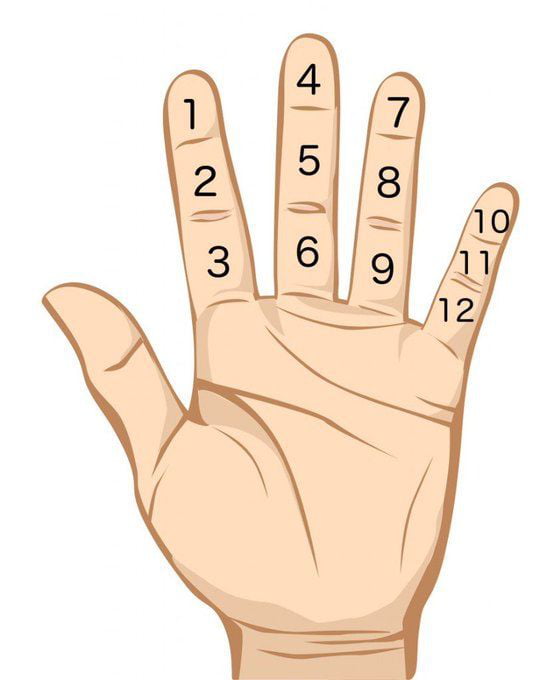I’ll be there at H:00.
Well it’s because noon means nine because the day starts at six o’ clock, so three is noon, but we use it to mean twelve which is closer to midday, obviously
This is basically a standup routine
Don’t forget about π
τ > π
τ = 2π, but yeah that’s another letter that we can’t help but get involved

IIRC they counted the bones in their fingers using their thumb and that gives 12. The first sundial was around the equator and there is always light for half a day, so half a day becomes 12 hours.
To count large numbers often one hand was used to count using 5 fingers and the other to count the bones, so you get 5x12 for 60 minutes.
AIUI there was an aspect in the divisibility of the numbers being convenient.
12 is divisible by 2, 3, 4, and 6. 60 is divisible by 2, 3, 4, 5, 6, 10, 12, 15, 20, and 30.
10 is divisible by 2 and 5. 100 is divisible by 2, 4, 5, 10, 20, 25, and 50.
If you want to minimize dealing with fractions, 12 and 60 are far more convenient than 10 and 100.
That’s an interesting thought, but I believe it to simply be a coincidence.
The base 12 counting being based on counting the division of your fingers is historically verified, but if the division aspect was so compelling to them you’d expect it to carry forward into their writing system.
By the time you get cuneiform math though, they actually go back to base 10.
https://images.app.goo.gl/9GR6VEiT7GHYF3KaA
As you can see base 12 is not in the written system, or for written mathematics. It just was convenient for counting on their hands.
They used mixes of base 10/base 12 and base 60.
Base 10 would be used go determine the symbols for a specific “digit” in base 60.
So similar to how our 13 is 1 ten and 3 ones, their 13 was the symbol for 10 then 3 symbols for 1. 13 = 𒌋𒁹𒁹𒁹 But 73 would be written 𒁹 𒌋𒁹𒁹𒁹
Which would be interpreted as 1 sixty and 13 ones, or 60 + 13
I’ma start a revolution where we use duodecimal metric for everything, including time.
That’s how we ended up with 12 months of varying length in a year and it’s a mess.
It’s a problem no matter how you divide the year
That’s why I propose changing the orbit of the earth, too
Not if you divide by 5. It gets you 73 days each.
Ok, but now subdivide the 73 day month-analogs into week-analogs.
I can see calling the month analogs “seasons”, but 73 is a prime number so you’re boned. We need subdivisions smaller than that for practical purposes
13 months of 4 weeks + new year’s day (+leap day) actually fits perfectly.
I wouldn’t call having an unassigned remainder “perfectly”. And always, leap day fucking shit up lol
If you want to be mad about time then I’d like to introduce you to a little thing I like to call the Gregorian calendar.
Sounds like a Michael McIntyre bit
Sundials.
Now if you want to get really pissed, the magnetic North Pole is actually the South Pole of the Earth’s magnetic field. We call it the North Pole because the north side of a magnet points to it.
deleted by creator
Actually, we call it the North Pole because we already had a concept of North from the North Star. Then we invented magnets and decided that the part that points North is the North side of a magnet (despite North Pole being magnetic south).
Don’t tell them about positive/negative electron movement.
Somebody never had a clock with roman numerals and it shows
I remember getting into an argument with a grade school teacher over IIII because most such clocks put that for 4 instead of IV because of some fuckin reason
Weird, I’ve seen many analog clocks with Roman numerals but always IV for 4.
It’s actually called the “clockmakers four” or “watchmakers four.” it’s a thing.
Yeah I looked it up and saw it is a thing, and it’s interesting. I wonder if the clock I’m thinking of was just a really cheap one that was labeled as you’d expect based on Roman numerals or whether some just didn’t follow it.
To be fair, Google searching Roman numerals clocks give you about a 50/50 distribution.
I wasn’t aware of this either and I suspect we’re not alone. It’s not highly noticeable and if there’s a 50-50 chance won’t even see it…
False. I had a clock that used IIII instead.
Your clock having it doesn’t change that mine didn’t.
I despise these so so much. IIII was historically NEVER correct. Some doofus decided to put that on a clock because it looks more symmetrical with the VIII on the other side. Terrible reasoning.
“However, even though it is now widely accepted that 4 must be written IV, the original and most ancient pattern for Roman numerals wasn’t the same as what we know today. Earliest models did, in fact, use VIIII for 9 (instead of IX) and IIII for 4 (instead of IV). However, these two numerals proved problematic, they were easily confused with III and VIII. Instead of the original additive notation, the Roman numeral system changed to the more familiar subtractive notation. However, this was well after the fall of the Roman Empire.”
https://monochrome-watches.com/why-do-clocks-and-watches-use-roman-numeral-iiii-instead-of-iv/
IIII was the way Romans usually wrote 4. It’s associated with simplicity / illiteracy. But also depended on era, region, intended audience, or practicality. I think the most famous example is the coliseum using LIIII.
There’s still variation even now; standardization is relatively new, and it’s not common knowledge. And dates… it’s like every 50-100 years people decided to write them differently.
deleted by creator
piece of art
ten ten
A lot of people white knighting clocks in this thread
The french:

Goddamn metric time
Even the French figured out that decimalized time was stupid after a couple of years.
Which has added credence to the old saying that “The French follow no one. And no one follows the French.”
Why is it stupid beyond, “nobody else uses it”?
Well, beyond the sheer social resistance to the idea. Turns out everyone needs to agree it’s a great idea and almost no one did. Evidently humans are wired to the base12 time format far better.
The attempt at switching to base10 time quickly fell apart when people started notice that the the “time markers” were starting to drift. And at some point they finally figured out that what we call “noon” was going drift rather quickly to not happening until evening and therefore Monday was going to move to a different spot also. This is a very bad thing. Because any kind of calendaring system needs to be as consistent as possible. Noon must happen at the same point in the day every day or as close to it as it it can mathematically get. If it drifts to fast and far, then it’s a worthless marker for time. And decimal time has that problem in spades.
Now, no calendar system is perfect because the orbits of the planets in our solar system isn’t perfectly consistent. Sometimes the orbit of earth is a tiny bit faster or sometimes it’s a tiny bit slower. So we strive to get a close as we can but we still need to make adjustments. Turns out, all that math is really bloody hard.
??? That’s not how it worked at all.
They still had the same length of time per day; 24 hours was equal to 10 french hour, each french hour was 100 french minutes, and each french minute was 100 french seconds. So noon arrived at 5 every day.
I kinda want to try it out lol
Now I really want a .beats watch. That’s so retro cool.
If you’re ok with a screwdriver, you can mod a Casio F91-W and add a .beat watchface https://www.sensorwatch.net/docs/watchfaces/clock/#beat-time
Why does everything that comes from Switzerland always seem to be owned by Swatch? Do they not have any other brands there?
Why the ‘IIII’ insted of ‘IV’?
i’m pretty sure that IV is a modern typographic thing
I’ve also heard that, because in Latin IV is the beginning of “IVPPITER” (Jupiter), there’s a theory that people avoided using “IV” as to not “disrespect” the god’s name. 🤷♀️
Also, on a 12 hour clock, 3 sets of four looks clean af I guess, e.g.:
- I, II, III, IIII
- V, VI, VII, VIII
- IX, X, XI, XII
May as well just go with VIIII then. Or maybe 9.
IIIIIIIII
Since the IIII usage is common in the Middle Ages and even into the Early Modern Period, when nobody believed in Jupiter, that is obviously just something somebody made up.
It could have also started from that and continued on despite people not knowing the reason, no? I do agree that it’s quite silly and unlikely, though.
Prevents confusion between the four and the six: III, IV, V, VI, when the watch is not held perfectly vertically for viewing.
Actually very common in watches with roman numbers iirc
6 means 30 is some toilet paper math

Also see this: https://gist.github.com/timvisee/fcda9bbdff88d45cc9061606b4b923ca
It amazingly explains all the insanities for handling dates and times.









